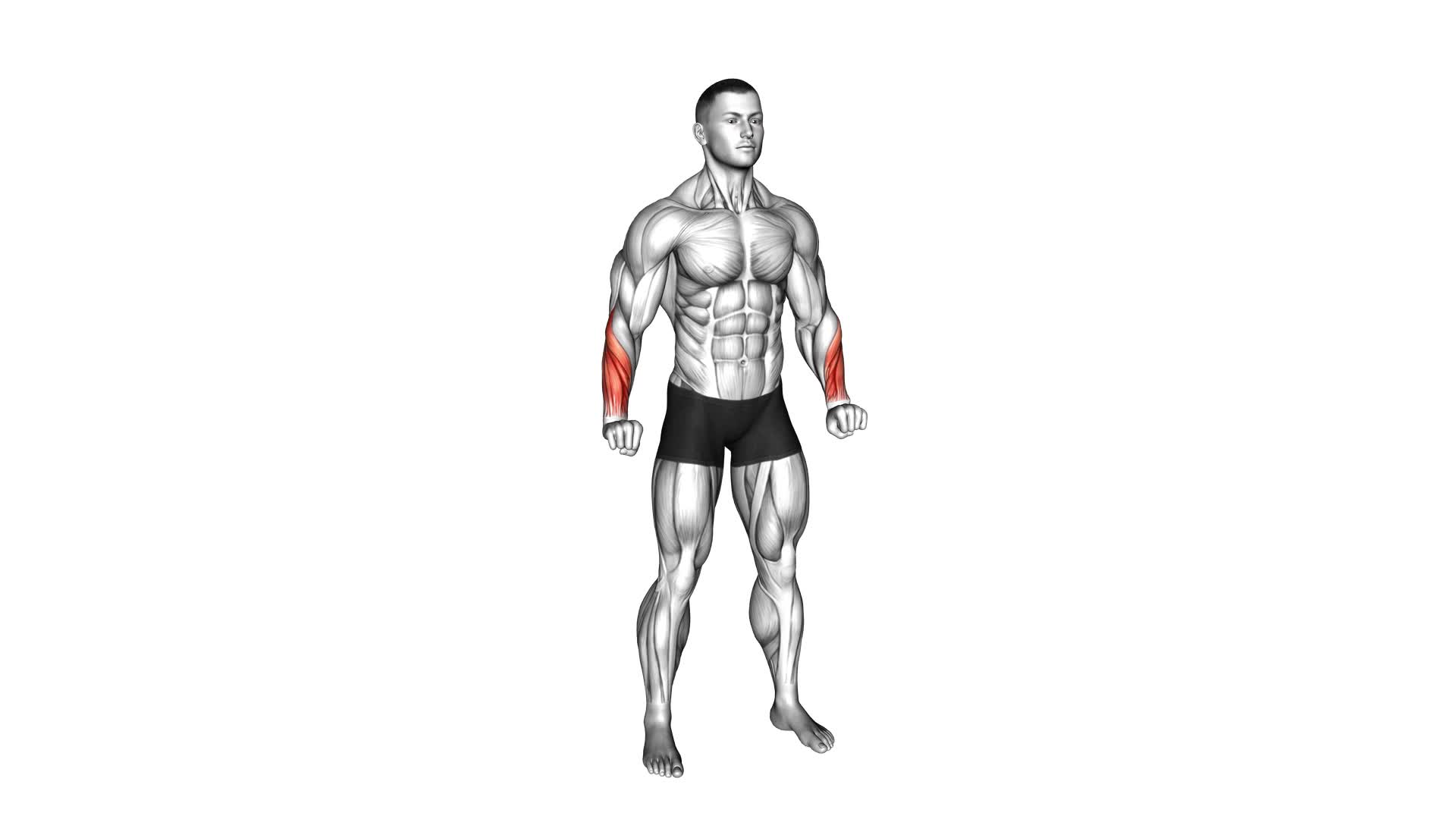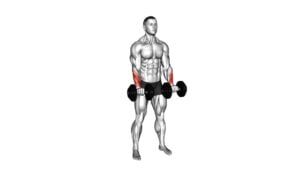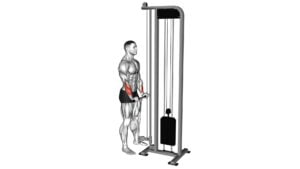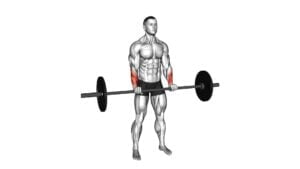Reverse Wrist Curl (male) – Video Exercise Guide & Tips

Are you looking to strengthen your wrists and improve your grip?
Watch This Exercise Video
In this video exercise guide, we'll show you how to properly perform the reverse wrist curl.
With just a few simple steps, you'll be on your way to building stronger wrists and achieving better control.
Don't let weak wrists hold you back – incorporate the reverse wrist curl into your workout routine and experience the benefits firsthand.
Let's get started!
Key Takeaways
- Proper form and technique are essential to avoid injury and maximize the benefits of the reverse wrist curl exercise.
- Gradually increase the weight or resistance to continually challenge and strengthen the forearm muscles.
- The exercise targets the extensor muscles in the forearms, improving grip strength, wrist flexibility, and stability.
- Regular performance of the reverse wrist curl can help prevent wrist injuries, enhance overall hand and wrist strength, and support functional activities and sports performance.
Proper Form for Reverse Wrist Curl
How can you perform the Reverse Wrist Curl with proper form? The Reverse Wrist Curl is a highly effective exercise for targeting the muscles in your forearms. To perform it correctly, start by sitting on a bench or chair with your feet flat on the ground. Hold a dumbbell in each hand, palms facing down. Rest your forearms on your thighs, allowing your wrists to hang off the edge. Slowly lower the dumbbells towards the floor by bending your wrists, then curl them back up as high as you can. Make sure to keep your forearms stationary throughout the movement, using only your wrists to perform the curl.
Now, let's talk about common mistakes to avoid when performing the Reverse Wrist Curl. One frequent error is using too much weight, which can lead to improper form and potential injury. It's important to start with a weight that allows you to maintain proper technique and gradually increase the resistance as you get stronger. Another mistake is using momentum to swing the dumbbells up, rather than relying on the strength of your wrists. This not only reduces the effectiveness of the exercise but also puts unnecessary strain on your joints. Lastly, avoid bending your elbows or moving your forearms during the movement. Keeping them stationary ensures that the targeted muscles in your forearms are properly engaged.
Now that you know how to perform the Reverse Wrist Curl with proper form and how to avoid common mistakes, let's discuss the benefits of this exercise. The Reverse Wrist Curl primarily targets the muscles in your forearms, including the extensor muscles. These muscles are responsible for extending your wrists and are often neglected in traditional workout routines. By strengthening these muscles, you can improve your grip strength, enhance forearm stability, and reduce the risk of wrist injuries.
Additionally, the Reverse Wrist Curl can also improve your overall wrist flexibility and range of motion, allowing you to perform daily activities with ease. Incorporating this exercise into your routine can help you achieve well-rounded forearm development and support your overall fitness goals.
Equipment Needed for Reverse Wrist Curl
To perform the Reverse Wrist Curl, you'll need a bench or chair and a pair of dumbbells. Here are the essential equipment needed for this exercise:
- Bench or chair: Choose a sturdy bench or chair that allows you to sit comfortably with your feet flat on the floor. This will provide stability and support during the exercise.
- Dumbbells: Select a pair of dumbbells that are appropriate for your fitness level. Start with lighter weights and gradually increase as you become stronger. The dumbbells will be used to load the muscles in your wrists during the exercise.
- Wrist wraps (optional): If you have weak wrists or are recovering from an injury, using wrist wraps can provide additional support and stability.
- Exercise mat (optional): Placing an exercise mat under your bench or chair can provide extra cushioning and prevent slipping during the exercise.
These are the basic equipment needed for the Reverse Wrist Curl exercise. However, if you don't have access to a bench or dumbbells, there are alternative exercises for wrist strength that you can try. Now, let's move on to the step-by-step guide to performing the Reverse Wrist Curl.
Step-by-Step Guide to Performing Reverse Wrist Curl
To perform the Reverse Wrist Curl exercise, you'll need to sit on a bench or chair with your feet flat on the floor. Here is a step-by-step guide to help you perform this exercise correctly.
- Hold a dumbbell in each hand, palms facing down.
- Rest your forearms on your thighs, allowing your wrists to hang over your knees.
- Slowly curl your wrists upward, bringing the dumbbells towards your body.
- Pause for a moment at the top of the movement, then slowly lower the dumbbells back down to the starting position.
- Repeat for the desired number of repetitions.
This exercise targets the muscles in your forearms, specifically the extensor muscles. It helps to improve wrist strength and stability, which is important for various activities and sports.
It is important to note that if you have any common wrist injuries, such as carpal tunnel syndrome or tendinitis, you should consult with a healthcare professional before attempting this exercise. They can provide guidance on whether it's safe for you to perform and recommend alternative exercises for wrist strength that may be more suitable for your condition.
Remember to start with a light weight and gradually increase as your strength improves. Proper form and technique are key to prevent injury and maximize the benefits of this exercise.
Common Mistakes to Avoid During Reverse Wrist Curl
Avoid these common mistakes when performing the Reverse Wrist Curl exercise to ensure proper form and maximize the benefits:
- Gripping the weight too tightly: It's important to maintain a relaxed grip on the weight to avoid straining the muscles in your forearm. Hold the weight with a loose grip to allow for a full range of motion.
- Using momentum: Avoid swinging your arm or using your shoulder to lift the weight. This takes away from the targeted muscles and reduces the effectiveness of the exercise. Instead, focus on using only your wrist to perform the movement.
- Not maintaining a neutral wrist position: Keep your wrist straight throughout the exercise. Avoid bending it too far forward or backward, as this can put unnecessary stress on the joint and increase the risk of injury.
- Neglecting proper breathing technique: Remember to breathe throughout the exercise. Inhale before starting the movement and exhale as you curl your wrist upward. This helps to stabilize your core and maintain proper form.
By avoiding these common mistakes, you can ensure that you're performing the Reverse Wrist Curl exercise correctly and getting the most out of your workout.
Now, let's move on to some effective variations and tips for increasing the intensity of the reverse wrist curl.
Tips for Increasing Intensity of Reverse Wrist Curl
To increase the intensity of the Reverse Wrist Curl exercise, you can incorporate variations and techniques that challenge your forearm muscles even more.
One way to do this is by increasing the weight you use during the exercise. Gradually increasing the weight will help to build strength and muscle endurance in your forearms. Start with a weight that's challenging but still allows you to maintain proper form. As you become more comfortable, gradually increase the weight to continue challenging your muscles.
Another way to increase the intensity of the Reverse Wrist Curl is by trying different variations of the exercise. For example, you can perform the exercise with a barbell, dumbbells, or resistance bands. Each variation will target your forearm muscles in slightly different ways, helping to keep your workouts fresh and challenging.
By incorporating these tips, you can effectively increase the intensity of your Reverse Wrist Curl exercise and continue to make progress in your forearm strength and muscle development.
Now let's move on to the benefits of including the reverse wrist curl in your workout routine.
Benefits of Including Reverse Wrist Curl in Your Workout Routine
Including the reverse wrist curl in your workout routine can significantly improve your forearm strength and muscle development. Here are some key benefits of incorporating this exercise into your training:
- Importance of wrist strength in sports performance: Strong wrists are essential for athletes in various sports such as tennis, golf, basketball, and martial arts. The reverse wrist curl targets the muscles responsible for wrist extension, which can enhance your grip strength and overall performance in these activities.
- Variations of wrist exercises for overall forearm development: The reverse wrist curl is just one of the many exercises that can help you develop your forearms. By incorporating different variations such as dumbbell reverse wrist curls or barbell reverse wrist curls, you can target different muscles in your forearms, leading to well-rounded development and improved functional strength.
- Enhanced grip strength: The reverse wrist curl primarily targets the extensor muscles of the forearm, which play a crucial role in grip strength. By regularly performing this exercise, you can increase your ability to hold onto objects, making it easier to perform tasks that require a strong grip.
- Injury prevention: Strengthening your wrists can help prevent injuries such as sprains and strains, particularly for activities that involve repetitive wrist movements or high impact on the wrists. By including the reverse wrist curl in your routine, you can build resilience in your wrists, reducing the risk of injury during sports or everyday activities.
Incorporating the reverse wrist curl into your workout routine can provide numerous benefits for your forearm strength, grip, and overall sports performance. Consider adding this exercise to your training regimen to see improvements in these areas.
Frequently Asked Questions
How Many Sets and Reps Should I Do for Reverse Wrist Curls?
For reverse wrist curls, it's important to focus on proper form and gradually increase the intensity. Start with a weight that allows you to perform 2-3 sets of 10-12 reps with good technique.
As you get stronger, you can add more weight or increase the number of sets and reps. It's also beneficial to incorporate variations for reverse wrist curls to target different muscles and avoid plateau.
Remember to listen to your body and adjust the workout accordingly.
Can I Perform Reverse Wrist Curls With Dumbbells Instead of a Barbell?
Yes, you can definitely perform reverse wrist curls with dumbbells instead of a barbell. This exercise is a great alternative for targeting the muscles in your forearms.
By using dumbbells, you can achieve a greater range of motion and focus on each wrist individually. This variation also helps improve grip strength and wrist stability.
Should I Perform Reverse Wrist Curls on Both Wrists or Just One at a Time?
To perform reverse wrist curls, it's recommended to do them on both wrists at the same time. This ensures that both sides of your body are being worked equally.
Start with a weight that you can comfortably handle and focus on maintaining proper form and technique throughout the exercise.
Reverse wrist curls can help strengthen your forearm muscles and improve grip strength, making them a beneficial addition to your workout routine.
Can Reverse Wrist Curls Help With Carpal Tunnel Syndrome?
Reverse wrist curls can definitely help with carpal tunnel syndrome. By incorporating reverse wrist curls into your workout routine, you can improve overall wrist strength and mobility.
This exercise specifically targets the muscles responsible for wrist extension, which can help alleviate symptoms of carpal tunnel syndrome. Additionally, reverse wrist curls are effective in preventing and managing wrist injuries by strengthening the muscles and tendons in the wrist.
Incorporating this exercise into your routine can provide numerous benefits for your wrist health.
Is It Normal to Feel a Burning Sensation in My Forearms During Reverse Wrist Curls?
Feeling a burning sensation in your forearms during reverse wrist curls isn't uncommon. It's important to ensure proper form to avoid injury. Make sure your wrists are in a neutral position and avoid excessive wrist extension.
Common mistakes to avoid include using too heavy of weights and jerking the motion. Start with lighter weights and gradually increase as you build strength.
If the burning sensation persists or becomes painful, it's advisable to consult a healthcare professional.
Conclusion
Incorporating reverse wrist curls into your workout routine can be a valuable addition to strengthen and tone your forearms. By using proper form and avoiding common mistakes, you can effectively target the muscles in your wrists and improve grip strength.
With the right equipment and some tips to increase intensity, you can make the most out of this exercise and see the benefits in your overall fitness journey.

Author
Years ago, the spark of my life’s passion ignited in my mind the moment I stepped into the local gym for the first time. The inaugural bead of perspiration, the initial endeavor, the very first surge of endorphins, and a sense of pride that washed over me post-workout marked the beginning of my deep-seated interest in strength sports, fitness, and sports nutrition. This very curiosity blossomed rapidly into a profound fascination, propelling me to earn a Master’s degree in Physical Education from the Academy of Physical Education in Krakow, followed by a Sports Manager diploma from the Jagiellonian University. My journey of growth led me to gain more specialized qualifications, such as being a certified personal trainer with a focus on sports dietetics, a lifeguard, and an instructor for wellness and corrective gymnastics. Theoretical knowledge paired seamlessly with practical experience, reinforcing my belief that the transformation of individuals under my guidance was also a reflection of my personal growth. This belief holds true even today. Each day, I strive to push the boundaries and explore new realms. These realms gently elevate me to greater heights. The unique combination of passion for my field and the continuous quest for growth fuels my drive to break new ground.







